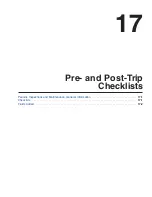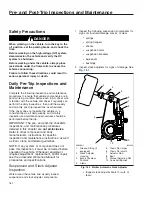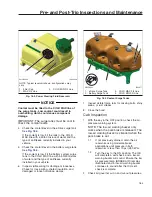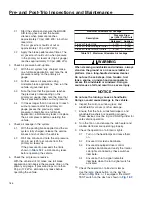
parking brakes must be applied before the
brake check valve will function.
1.
Inspect all visible brake system components for
missing fasteners or signs of looseness, such as
rust tracks.
NOTICE
If the external breather tube or breather cap is
missing or incorrectly installed, road dirt and
debris can adversely affect the operation of the
brake chamber. Once inside of the chamber, dirt
and debris can cause the internal parts of the
chamber to deteriorate faster.
2.
Inspect the exterior surfaces of brake chambers
for damage. Make sure that breather holes are
open and free of debris.
NOTE: Do not route air brake lines on top of
anything likely to be stepped on.
3.
Inspect air brake lines for dents, swelling, kinks,
twisting, abrasion, and damage, especially near
moving parts.
4.
Inspect flex air lines for deterioration or signs of
abrasion.
5.
Inspect for cracked, worn, or oil-contaminated
brake linings and brake drums (or rotors).
6.
Check the thickness of the brake linings.
Replace brake linings on all brake assemblies on
the axle if any brake linings are worn to less than
approximately 1/4 inch (6.4 mm) at the thinnest
point.
eAxle Inspection
1.
Check and inspect the rear pads.
2.
Check and inspect the mounting brackets for
loose bolts.
Mid-Frame Area Inspection
WARNING
When draining the air reservoir, do not look into
the air jets or direct them toward anyone. Dirt or
sludge particles may be in the airstream and
could cause injury.
NOTICE
If the water drained from the air reservoirs is
cloudy or oily, it may indicate a problem with the
compressor. If oil is allowed to contaminate the
air dryer, it will not remove the water from the air
brake system, which could adversely affect
braking.
1.
On vehicles without automatic drain valves, drain
the brake system air reservoirs.
IMPORTANT: Aerodynamic components
decrease drag force as a vehicle moves,
thereby improving fuel efficiency. If replacement
of an aerodynamic component is necessary,
replacement components must meet or exceed
the drag reduction performance of the originally
installed component in order to maintain
compliance with greenhouse gas and fuel
efficiency regulations.
2.
Inspect the following aerodynamic components, if
equipped, for structural damage, cracks, or wear.
•
Roof fairing/deflector
•
Side skirts
•
Cab extenders
Front Box Inspection and Adjustments
IMPORTANT: If replacement of the hood or
bumper is necessary, the replacement
component must meet or exceed the drag
reduction performance of the originally installed
item in order to maintain compliance with
greenhouse gas and fuel efficiency regulations.
NOTE: Anytime a hood is adjusted, removed, or
reinstalled, the headlamp aim should be
checked.
1.
Inspect the bumper and hood for structural
damage, cracks, or wear.
2.
Open the hood.
Inspect the radiators and heater hoses, including
the clamps and support brackets.
NOTE: When traveling through areas of high
insect concentration, it may be necessary to
clean the exterior of the radiators as often
as every 200 miles (320 km).
Pre- and Post-Trip Inspections and Maintenance
18.9
Содержание PX113064S T 2016
Страница 4: ......
Страница 10: ......
Страница 18: ......
Страница 57: ...f611343 09 28 2016 AIR SLIDE SLIDE LOCK Fig 4 18 Fifth Wheel Air Slide Dash Switch Driver Controls 4 8...
Страница 58: ......
Страница 83: ...6 Driver Assistance Features Electronic Stability Control ESC 6 1 PasSmart 6 1 SafetyDirect by Bendix 6 2...
Страница 86: ......
Страница 112: ......
Страница 122: ......
Страница 142: ......
Страница 154: ......
Страница 155: ...12 Steering System Power Steering System 12 1...
Страница 158: ......
Страница 159: ...13 eAxle eAxle 2 Speed Transmission 13 1...
Страница 176: ......
Страница 190: ......
Страница 202: ......
Страница 222: ......
Страница 223: ...20 Emissions Information Noise Emissions 20 1 Greenhouse Gas Emissions 20 1...
Страница 229: ......
Страница 236: ......






































